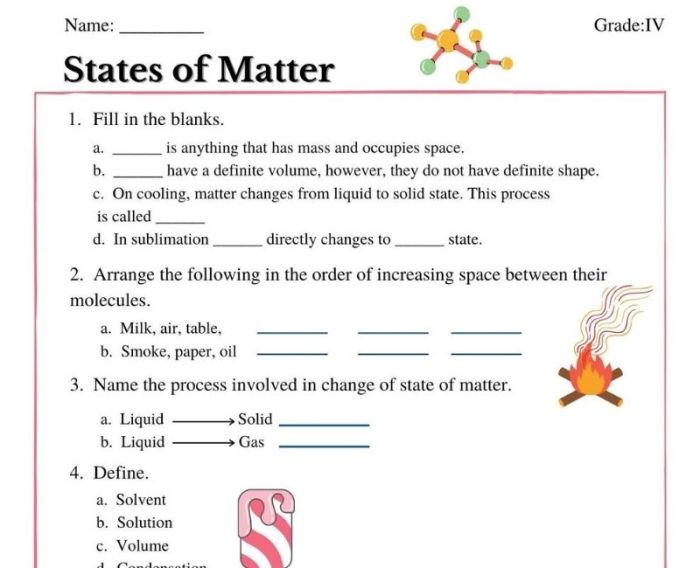Properties and interactions of matter worksheet answers – Embark on a journey of scientific discovery with our comprehensive guide to the properties and interactions of matter. Delve into the physical and chemical characteristics that define substances, unravel the forces that govern their behavior, and uncover the intricate relationships that shape the world around us.
This meticulously crafted resource unravels the complexities of matter, providing a solid foundation for understanding its diverse forms and interactions. From the macroscopic properties that distinguish solids, liquids, and gases to the microscopic forces that orchestrate chemical reactions, this guide illuminates the fundamental principles that underpin the material world.
Properties of Matter

Matter is anything that has mass and takes up space. It exists in three states: solid, liquid, and gas. Each state has unique properties that can be used to identify and classify matter.
Physical Properties
- Color:The color of a substance is determined by the way it absorbs and reflects light.
- Odor:The odor of a substance is caused by volatile molecules that are released into the air.
- Taste:The taste of a substance is caused by molecules that interact with taste receptors on the tongue.
- Texture:The texture of a substance is determined by the way it feels when touched.
- Density:The density of a substance is its mass per unit volume.
- Melting point:The melting point of a substance is the temperature at which it changes from a solid to a liquid.
- Boiling point:The boiling point of a substance is the temperature at which it changes from a liquid to a gas.
Chemical Properties
- Flammability:The flammability of a substance is its ability to burn.
- Reactivity:The reactivity of a substance is its ability to react with other substances.
- Acidity:The acidity of a substance is its ability to donate protons.
- Basicity:The basicity of a substance is its ability to accept protons.
Relationship between Properties and State
The properties of matter are related to its state. Solids have a definite shape and volume, liquids have a definite volume but no definite shape, and gases have no definite shape or volume. The state of matter is determined by the temperature and pressure of the substance.
Interactions of Matter
Particles of matter interact with each other in a variety of ways. These interactions affect the behavior of matter.
Types of Interactions
- Gravitational interactions:Gravitational interactions are attractive forces between objects with mass.
- Electromagnetic interactions:Electromagnetic interactions are forces between charged particles.
- Strong nuclear interactions:Strong nuclear interactions are forces that hold the nuclei of atoms together.
- Weak nuclear interactions:Weak nuclear interactions are forces that are responsible for certain types of radioactive decay.
Effects of Interactions, Properties and interactions of matter worksheet answers
The interactions between particles of matter affect the behavior of matter in a number of ways. For example, gravitational interactions cause objects to fall to the ground, electromagnetic interactions cause atoms to bond together to form molecules, and strong nuclear interactions hold the nuclei of atoms together.
Examples of Interactions
The interactions between particles of matter can be used to explain a wide variety of phenomena, such as magnetism, electricity, and chemical reactions. For example, magnetism is caused by the interaction of moving charged particles, electricity is caused by the flow of charged particles, and chemical reactions are caused by the interactions between atoms and molecules.
Essential FAQs: Properties And Interactions Of Matter Worksheet Answers
What are the key physical properties of matter?
Physical properties include density, melting point, boiling point, solubility, and conductivity, among others.
How do chemical properties influence the behavior of matter?
Chemical properties determine a substance’s reactivity, flammability, and ability to form bonds with other substances.
What are the different states of matter?
The three main states of matter are solid, liquid, and gas, each with distinct properties and molecular arrangements.